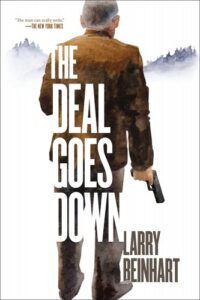There are two godfathers of modern crime writing, Dashiell Hammett and Raymond Chandler. For my money Hammett was the better writer. Even if Chandler had the gaudier patter. Chandler was a superb analyst of the genre. I’ve taken what he said about Hammett—in ordinary paragraph form—and turned it into a list.
- Hammett gave murder back to the kind of people that commit it for reasons …
- with the means at hand, not with hand-wrought dueling pistols, curare, and tropical fish.
- He put these people down on paper as they are, and he made them talk and think in the language they customarily used for these purposes.
- He had style, but his audience didn’t know it, because it was in a language not supposed to be capable of such refinements. …
- he did over and over again what only the best writers can ever do at all. He wrote scenes that seemed never to have been written before.”
That’s a set of standards to aspire to. To be guided and inspired by. That’s what makes Hammett’s five crime novels the five best works to measure ourselves against.

Red Harvest
“I first heard Personville called Poisonville by a red-haired mucker named Hickey Dewey in the Big Ship in Butte. He also called his shirt a shoit. I didn’t think anything of what he had done to the city’s name. … A few years later I went to Personville and learned better.”
That’s how Red Harvest opens. It’s a mining town.
A detective arrives.
He acts a lot like the lone heroes our fictional detectives have routinely become. But he’s not. He’s part of a major corporation, the Continental Detective Agency. In a sense, he’s not there as a person, he’s there as an operative, so Hammett doesn’t give him a name, he calls him the Continental Op.
The man who hired him is murdered the day the Op arrives.
They never get to speak. The Op doesn’t really know what he’s been hired for.
It’s a company town. The murdered man is the son of Elihu Wilson, who owns the place. When the mineworkers had gone on strike, he’d brought in thugs to beat them down. To kill them if necessary. It was the thing to do back then. Rockefeller, for example, did it.
The strike was broken. But the thugs stayed on. Pete the Finn had bootlegging, Lew Yard had loan sharking, Max “Whisper” Thaler had the gambling. The fourth gangster is Noonan, he’s Chief of Police.
Wilson hires the Op to find out who killed his son. Later, to clean up the town. Then changes his mind. The Op proceeds by pushing and prodding, using information and rumor to turns the various factions against each other. A two-sided, three-sided, four-sided war breaks out. Buildings burned down, blown up, machine guns in the streets. The whole town gets “blood simple.”
Red Harvest has never been officially made into a film. Unofficially, it is the blueprint for Yojimbo by Kurosawa. Yojimbo was remade as Fistful of Dollars, the first of Sergio Leone’s spaghetti western trilogy with Clint Eastwood, another man with no name.
The violence in those films seem totally excessive. Beyond reality. Movie stuff. As it does in the novel.
Except that Hammett was the real deal. He worked for the Pinkerton Detective Agency. In 1917 they sent him to Butte, Montana to help break up a strike by the IWW, the International Workers of the World. The Wobblies. While he was there he was offered five thousand dollars to kill union agitator Frank Little.
Hammett turned it down.
Shortly thereafter, six men broke into Little’s boarding house. They beat and abducted him. They tied him to the rear of a car, dragged him along the streets, then hung him from a railroad trestle.
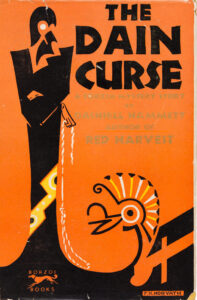
The Dain Curse
The detective is still the Continental Op. The agency is still a business that must make money. The Op still has to report to his superiors.
It’s set in the 1920s. Part of what’s so striking about the book is its modernity. Much of it could have been “torn from the headlines” in the 80’s or 90’s or even today. The young woman at the center of the story is addicted to opioids. She gets involved with a cult. It sounds very spiritual. It offers much, it sucks away all its members’ money. It’s mystical. It has its own special temple in the California hills. It has its own security and enforcers. It will make you think of Children of God, Jim Jones and The People’s Temple, Rajneesh, Scientology, Nxivm.
The Dain Curse is the weakest of Hammett’s books, but it’s over 90 years old, and the story it tells and the world it describes still feel alive.
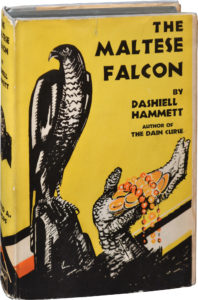
The Maltese Falcon
The center piece. The one.
I read somewhere, but I can’t, for the life of me, find the quote to credit it, that “Hammett did what Hemingway was said to have done.” The Maltese Falcon is where you can see it. The scenes feel like they were shot with a 50mm lens. It’s there. Straight on. See. This is what happened.
Hammett doesn’t tell you how characters feel or think or what their motivations are. He shows you what the characters do. He lets you hear what they say. They may speak about emotions and thoughts, but their speech is to provoke, entice, manipulate, threaten, to accomplish things. Their words are actions. And none of them are particularly honest.
The dialogue is excellent. Even snappy and quotable. Even though the prose is pared to its basics. Sentences to their essence. It’s cut in stone.
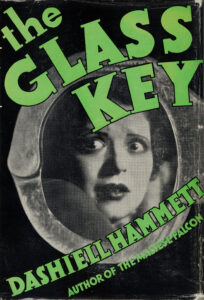
The Glass Key
The Glass Key is a novel of character.
Yes, there’s a murder. Whodunnit is a mystery. It even gets solved.
It takes place in a small city. A corrupt city. Near New York. Across the river.
The main character is Ned Beaumont. He’s a gambler. He’s also the best friend and right-hand man of Paul Madvig, the political boss of this unnamed municipality. Paul wants to rise up in the world and marry the senator’s daughter. The senator is more corrupt than Paul or Ned, but all Paul can see is the senator’s thick coating of upper crust.
Janet, the upmarket daughter, hates Paul. She falls in love with Ned.
There’s a gangster, Shad O’Rory, who thinks Paul is getting weak and it’s time to take over the town.
Everyone acts out of who they are. The specific circumstances could be changed – who was murdered, who did it, which woman was the object of attention, who was coming after Paul, a different gangster, an attorney general, a reformer – and all these people would end up in some similar dance. Paul would still think he’s immune from attacks and it’s his time to rise. Ned would still do everything he could – even take beatings, end up in the hospital – to save Paul – from others and from Paul own mistakes. It’s a love affair. Not a closeted one, an asexual one. Ned is a gambler. The kind, it would seem, who likes to lose. He’s very attractive to women. When the one who’s important, the senator’s daughter, comes along, Ned does try to keep his distance. But she’s manipulative too. Dangerous. Like everyone playing in this sandbox, in their own ways. But if it wasn’t Janet, it would’ve have been some other woman, sooner or later. If Paul and Ned got over that, it would have been something else, maybe a murder, or a betrayal, that their friendship – their love, their loyalties – couldn’t stand. It was going to go that way, though both of them wished it wouldn’t.
It’s Walter Stroby’s favorite Hammett. Even more than The Maltese Falcon.
“This wasn’t about colorful criminals chasing each other around the globe in pursuit of a mythical treasure. This was about men and women, friendship and loyalty, power and corruption. It felt real. It felt like life.”
It was made into a film three times. 1935, starring George Raft, Edward Arnold, and Claire Todd. 1942, with Alan Ladd, Brian Donlevy, and Veronica Lake. 1990, by the Coen brothers. They called it Miller’s Crossing. The IMDB list of the writing credits has “Dashiell Hammett (novels) (uncredited)”. The onscreen credits don’t mention him at all. But it’s so alike that even the apartment of the Ned Beaumont character (called Tom Reagan) is as described in the book.
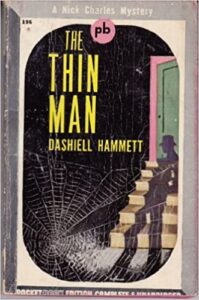
The Thin Man
The Thin Man launched another set of archetypes. Nick and Nora Charles, sophisticated, high society, wise-cracking, constantly drinking, crime solvers.
Nick is an ex-police detective. He still has many connections among the denizens of the lower depths. Both criminals and cops remember him fondly. He’s married up. Way up. Nora is an heiress to millions. The rest of the story – who killed whom, how it gets solved – matters far less than keeping company with these two charmers.
The film was quite faithful to the book. Roger Ebert called it “a screwball comedy with dead bodies.” It’s a very accurate depiction both.
The film had five sequels. After the Thin Man, Another Thing Man, Shadow of the Thin Man, The Thin Man Goes Home, and Song of the Thin Man. It set the scene for countless imitations: Hart to Hart, McMillan & Wife, Mr. & Mrs. North, Remington Steele, Moonlighting, Burn Notice, to name a few.
I was about 20 the first time I read it. I experienced it just the way it was played by William Powell and Myrna Loy, witty, charming, and fun
Sometime in my forties, maybe fifties, I read it again. It was as if I was reading a completely different book. Two alcoholics. For all their witticisms and their night clubbing lifestyle, drinking their lives away. So much success, they didn’t need success. With money they no longer needed to earn, it just kept coming. It was about two people who no longer had any meaning in their lives. It was as sad as sad can be.
I felt that I knew why Hammett was never able to write another book.
*
All of my novels touch back to Hammett. Sometimes in large ways, sometimes small.
The protagonist in my most recent, The Deal Goes Down, quotes a line, by way of explaining his own actions. It’s from a short story, The Gutting of Couffignal. Early on, there’s a chase. The Op twists his ankle. There’s a one-legged newsboy. The Op borrows his crutch to go after the bad guys. By the end of the tale he’s found out that the real villain is the beautiful woman. She starts to walk away, certain the Op won’t shoot because she’s a woman. He’s never shot a woman.
He shoots her. Then he says, “You ought to have known I’d do it. … Didn’t I steal a crutch from a cripple?”
***


